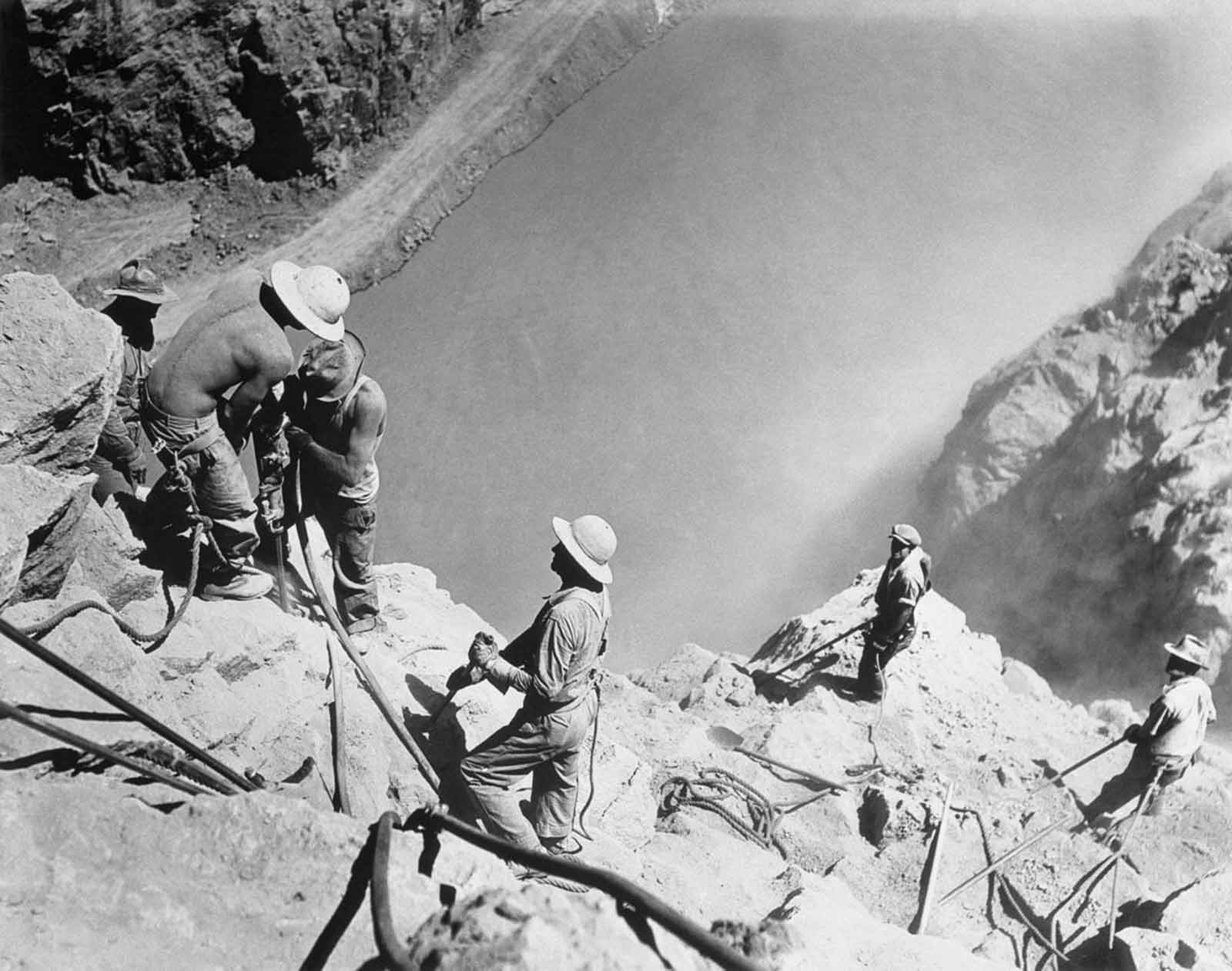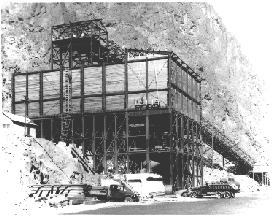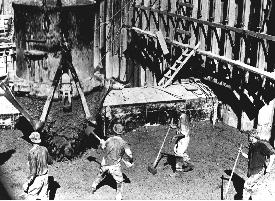Hoover Dam is as tall as a 60-story building. It was the highest dam in the world when it was completed in 1935. Its base is as thick as two football fields are long. How many workers died building Hoover Dam?
During the construction period from 1931 to 1936, it is estimated that approximately 112 workers died due to various accidents and occupational hazards. These fatalities occurred in the challenging conditions of the construction site, the harsh desert environment, & demanding nature of the work.
The amount of concrete used in building it was enough to pave a road stretching from San Francisco to New York City. The dam had to be big. It held back what was then, and still is, the largest man-made reservoir called Lake Mead in the United States. The amount of water in the lake, when full, could cover the whole state of Connecticut ten feet deep. Only a huge dam could stand up to the pressure of so much water.
Introduction:
Perched along the chasm of the Colorado River lies a colossus of concrete and human ambition—the Hoover Dam. This monumental structure, a testimony to engineering might, conceals within its history a darker narrative of sacrifice. Rumors swirl like the river’s eddies about the laborers who met their demise in the dam’s construction, fueling macabre speculation: are their bodies entombed within its stoic walls? Our in-depth article delves into the factual abyss, separating myth from mortality, and shedding light on the Hoover Dam’s grim toll of deaths and fatalities.
Hoover Dam Deaths and Fatalities
The Hoover Dam, once known as Boulder Dam, stands as a monumental feat of engineering, nestled in the rugged desert landscapes on the border between Nevada and Arizona. Its colossal concrete presence, commanding respect from Las Vegas to beyond, belies a dam history marked by triumph and tragedy.
The construction project embarked upon during the Great Depression era wasn’t just an undertaking of immense business significance; it was a heavily weighted game against time and the unforgiving elements. The whispers of the Hoover Dam deaths often conjure images of bodies entombed within its great concrete walls; however, this is merely a macabre myth of the reclamation project.
Let’s sift through the sands of time to January 1931 when the project first broke ground. Men were drawn from all corners, lured by the promise of employment as the country was reeling from economic despair. Over five years, Patrick and his hardy fellows, alongside thousands of others, committed themselves to the mammoth task at hand.
Soon after the dam was authorized, increasing numbers of unemployed people converged on southern Nevada. Las Vegas, then a small city of some 5,000, saw between 10,000 and 20,000 unemployed descend on it. 1933.
Day and night, the site bustled with people fervent to tame the wild Colorado River. Yet, this undertaking was not without its cost. The dam fatalities are a solemn chapter in an otherwise remarkable history. Indeed, many did lose their lives—96 are officially recognized—to hazards that were part and parcel of this historic endeavor.
The dam’s construction was a gritty business; workers battled carbon monoxide poisoning in the tunnels, falls from sheer cliffs, and even heat-related fatalities during the sweltering Nevada summers. The concrete poured to create this monolithic dam claimed no bodies within its layers, despite the popular and morbid rumors. Instead, those who died were afforded their final respects elsewhere, away from the site where they had given so much of themselves. The Hoover Dam stands testament not only to human ingenuity and resolve but also to those whose lives were irretrievably interwoven with its history.
Today, as tourists gaze upon the impressive expanse from the safety of the observation deck, few can grasp the magnitude of the dam’s construction phase. The Hoover Dam wasn’t merely another project; it was an epoch of American resolve and ambition. Despite the hardships endured, and the lives tragically cut short, the dam remains an emblem of progress—a literal cornerstone of reclamation that has transformed arid basins into habitable and prosperous regions. It’s a poignant reflection of the time when people toiled for a brighter future, understanding the inherent dangers, yet spurred by the hope that permeated the business of survival and growth.
As such, if you’ve ever journeyed to Las Vegas or meandered through the Nevada panoramas, spare a thought for the Hoover Dam at Lake Mead. It’s not just an engineering marvel, it’s a reliquary of dreams, sacrifices, and unflagging spirit that should be recognized every January, and all year round, for its unparalleled contribution to our nation’s history and the indomitable human spirit that powered its rise.
The myth of bodies buried within the dam’s concrete heart will forever persist in the annals of lore, but the truth is far more respectful and somber—a tale of courage and human endeavor written in sweat, toil, and the profound respect due to those who indeed have etched their legacy into the dam’s formidable silhouette.
During the construction period from 1931 to 1936, it is estimated that approximately 112 workers lost their lives due to various accidents and occupational hazards. These fatalities occurred in the challenging conditions of the construction site, including the harsh desert environment and the demanding nature of the work.
The names and details of individual fatalities may not be readily available in the public domain. If you have a specific inquiry or are looking for more detailed information on a particular aspect, you may consider reaching out to historical archives, government records, or the U.S. Bureau of Reclamation, which oversees Hoover Dam.
The Tragic Reality Behind Hoover Dam Fatalities and the Myth of Buried Workers
There were 112 deaths associated with the construction of the dam. The first was J. G. Tierney, a surveyor who drowned on December 20, 1922, while looking for an ideal spot for the dam.
The last death on the project’s official fatality list occurred on December 20, 1935, when an “electrician’s helper”, Patrick Tierney, the son of J. G. Tierney, fell from an intake tower. Included in the fatality list are three workers, one in 1932 and two in 1933, who committed suicide onsite.
Ninety-six of the deaths occurred during construction at the site. Of the 112 fatalities, 91 were Six Companies employees, three were BOR employees,(Bureau of Reclamation) and one was a visitor to the site, with the remainder employees of various contractors not part of Six Companies.
The construction of Hoover Dam, a monumental engineering project during the Great Depression, was marked by a tragic reality of fatalities. While estimates suggest around 112 workers lost their lives during the construction from 1931 to 1936, the true number may be higher due to incomplete records.

The challenging conditions of the construction site, including extreme heat and demanding work, contributed to accidents and occupational hazards. Contrary to a persistent myth, there is no evidence supporting the claim that workers’ bodies were buried in the concrete of the dam itself. The sacrifices of those who lost their lives during Hoover Dam’s construction are remembered, emphasizing the importance of worker safety in major infrastructure projects.
The Hoover Dam, an engineering marvel that tamed the Colorado River, is no stranger to tales of valor and tragedy. Amidst the dust of construction and the roar of concrete pouring, the dam whispered stories of its makers, the brave men who toiled. Among these narratives, the most chilling perhaps is that of the fatalities—the lives claimed during the dam’s construction.
The grim ledger of death tallies more than a hundred dam workers, each a heartbreaking testament to the perilous nature of erecting such a monolith. Often, when recounting these stories, a pervasive myth emerges the claim that bodies remain forever entombed within the dam’s colossal blocks. The truth is there are none.
Yet, such tales stray far from the concrete truth; no workers are buried in the dam. Although fatalities were a somber reality of the project, the methods used in the dam’s construction ensured that no such macabre mistakes occurred.
Nonetheless, the specter of death did not only stalk during the daylight hours of labor. Dam suicides added a harrowing layer to the already dark folklore of the site. Workers, struggling with the strain of their monumental task, the oppressive desert heat, or personal demons, sometimes saw in the dam’s towering edifice the grim allure of oblivion. This dark impulse, to commit suicide amidst the canyons echoing with the toil of industry, underscores the need for ongoing conversations about suicide prevention, even in the hardiest of professional communities.
The Hoover Dam’s construction was, in fact, a place of huge amounts of danger. Beyond the risks of mortal injury or the decision to commit suicide, men battled against the fury of elements within the diversion tunnels—monster passages hewn through the rock to reroute the mighty Colorado. Now silent sentinels to the past, these tunnels were once cacophonous with the sounds of drilling and dynamite, places where any misstep or miscalculation might suffice to snatch away a life.
Workers who faced their demise at the dam were often the victims of calamitous accidents—falls from the dizzying heights, mishaps with machinery, or the lethal embrace of Colorado’s churn. Each death punched a hole in the community of dam workers, the heartache of lost comrades mingling with the dust in the air. And with each bereavement came the stark reminder that the line between triumph and tragedy is as fine as the cracks in the desert earth.
The Hoover Dam stands today not just as a symbol of human ingenuity but as a monument to those who spared no effort—or in too many cases, their lives—to give it shape. Memorials now pay homage to these souls, ensuring their stories are not lost amid the concrete and steel. It’s a place where the ghosts of the past linger, reminding us of the human cost and the irrefutable value of each life that contributed to this titan of electricity and water.
Confronting the Hoover Dam’s legacy is to wrestle with the paradox of awe and anguish, to balance celebration with commemoration. We hold space for the deceased in our collective memory—not as phantoms buried within the structure but as men of flesh and bone whose departure cast long shadows over the waters they helped to command. Thus, the dam stands, a testament to both human might and the delicate fragility of human existence, a tribute that should inspire our continued commitment to safety measures and suicide prevention for all who labor in the shadow of giants.
Hoover Dam History and Construction Challenges of Hoover Dam’s Concrete
The monumental Hoover Dam stands as a pinnacle of human perseverance, its colossal concrete blocks testament to the ingenuity of a bygone era. Enveloped by the arid expanse of the Las Vegas neighboring deserts, this mammoth structure didn’t just tame the harmonious but relentless flow of water, it narrated a story steeped in scientific marvels and tragic sacrifice. When diving into the origins of this bridge between nature and technology, one cannot overlook the intense construction challenges that the brave souls faced in transforming a turbulent river into a beacon of civilization.

At the very heart of this engineering venture was concrete – not just any mix, but an extraordinary blend that would endure the tests of weather, water pressures, and time. Dam construction became a symphony of science, where each tier of the dam was envisioned like a mammoth jigsaw puzzle.

These concrete giants, towering sometimes hundreds of feet above the canyon floor, addled the minds of engineers and laborers alike.
Yet, they fathomed the depths of their craft and laid down block upon block, metering the strictest of standards to create a dam resistant to the whims of nature. It’s enthralling to watch a video depicting the enormity of these endeavors, enlightening viewers to the surreal scale of operations undertaken.
Every tier contributed to a higher purpose, transcending mere functionality. It symbolized the triumph of collaborative labor and relentless human spirit over the daunting obstacles of nature. Yet, while the masses celebrate the dam’s success, the darker hues of history suggest a grim narrative.
The hard-jawed laborers, known affectionately as “High Scalers,” dangled precariously from the vertical canyon walls, defying gravity to sculpt the dam’s face. There lies a tale of bravery but also of heartache, as fatalities became the silent whispers amid the clattering of machines. Echoes of names, like Tierney – the first recorded casualty, hallmark the dam’s legacy, a solemn reminder of the cost paid in human lives.

It’s harrowing to consider the chilling myth that entombs the very foundation of this marvel. Whispers have long suggested that there might be bodies buried within Hoover Dam’s concrete blocks – a legend that has captivated the morbid curiosity of many.
The weight of these conjectures is heavy, yet upon closer inspection, experts debunk these macabre tales, assuring us that no mortal remains disrupt the dam’s somber tranquility. It’s a mix of relief and sorrow, understanding that while no one lies entombed within the concrete mass, the shimmering waters of Lake Mead mirror not just the skies but the fallen dreams of those who never made it back to Las.
The bridge that Hoover Dam forms between the past and the future cannot be understated. It’s a living laboratory for water management and a monumental exhibit of early 20th-century industrial might.
However, as much as science can rationalize the existence of the dam, it’s the human stories interlaced within its blocks, both factual and folklore, that truly bridge the period, connecting us to those who dared defy the desert.
To protect the construction site from the Colorado River and to facilitate the river’s diversion, two cofferdams were constructed. Work on the upper cofferdam began in September 1932, even though the river had not yet been diverted. 1933. As seen at the right.
And thus, let every foot trodden upon this monolith serve as a tribute, not just to what was built, but to who built it – at a staggering price that is often overshadowed by Hoover Dam’s grand silhouette against the Nevada sky.
Conclusion:
Hoover Dam, initially known as Boulder Dam, is a monumental structure on the Colorado River, straddling the border between Nevada and Arizona. Its construction took place during the Great Depression, from 1931 to 1936. The dam was built to control the river’s flow, provide water for irrigation, and generate hydroelectric power. One of the most significant challenges during construction was the sheer volume of concrete needed. The process of pouring concrete in massive blocks presented logistical challenges, and innovative cooling pipes were used to manage the heat generated during the curing process in the desert environment. The successful completion of Hoover Dam not only tamed the Colorado River but also stood as a testament to engineering ingenuity during a challenging historical period.
References:
Bureau of Reclamation- Hoover Dam
The National Park Service- The Greatest Dam in the World
FAQ’s
- How many deaths have occurred during the construction of Hoover Dam During the construction of Hoover Dam, officially known as the Boulder Dam, around 96 deaths were reported. However, some estimates suggest the number could be higher due to unrecorded incidents and the harsh working conditions.
- What were the main causes of fatalities during the construction of Hoover Dam The main causes of fatalities included accidents related to falls, heatstroke, drowning in the Colorado River, and incidents involving heavy machinery and equipment.
- Were there any notable accidents or tragedies during the construction of Hoover Dam One of the most notable accidents was the collapse of a cofferdam in 1933, resulting in the deaths of several workers. Additionally, numerous workers suffered from heat exhaustion and heatstroke due to the extreme desert temperatures.
- How were worker safety and conditions addressed during the construction of Hoover Dam? Despite the dangers and challenges, efforts were made to improve worker safety and conditions. Measures included providing shade, rest breaks, and implementing safety protocols for working at heights and around machinery.
- Did the deaths at Hoover Dam impact the completion of the project While the fatalities undoubtedly had an impact on morale and productivity, the construction of Hoover Dam continued, eventually reaching completion in 1936.
- Are there any memorials or commemorations for the workers who lost their lives during the construction of Hoover Dam? Yes, there are memorials and plaques dedicated to the workers who lost their lives during the construction of Hoover Dam, honoring their contributions and sacrifices.
- Has worker safety improved in modern dam construction projects compared to the time of Hoover Dam’s construction? Yes, advancements in technology, safety regulations, and awareness have significantly improved worker safety in modern dam construction projects. However, construction remains a hazardous industry, and safety protocols are continually evolving to mitigate risks.



